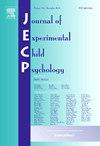视觉线索对减少儿童互动故事书认知负荷的影响
IF 1.8
2区 心理学
Q3 PSYCHOLOGY, DEVELOPMENTAL
引用次数: 0
摘要
交互式图书应用程序通过同时传递视觉和口头信息,同时通过交互式元素积极吸引用户,从而增强学习效果。这样可以通过积极参与来促进学习。然而,这些互动功能也会分散学生的注意力,增加认知负荷。为了解决这个问题,屏幕上的视觉信号交互元素可以帮助引导注意力,促进多模式内容的整合。因此,本研究旨在探讨互动元素的视觉信号是否可以减轻认知负荷,进而提高儿童的学习成绩。将119名儿童(M = 9.35, SD = 0.684)分为四组:(1)有信号交互应用组,(2)无信号交互应用组,(3)视频组,(4)静态图片对照组。孩子们听了一本以科学为主题的书,书中有各种互动和多媒体元素。学习结果通过包含16个问题的回忆测试来评估。注意缺陷多动障碍评定量表(ADHD Rating Scale-IV)用于评估注意机制,由班主任完成评估。互动应用组的儿童比静态图片对照组的儿童回忆起更多的信息。视频组的孩子与对照组有显著差异,但与互动应用组没有显著差异。然而,有注意力困难的儿童在观看多媒体视频或互动功能没有视觉信号时往往表现更差。当交互特征发出信号时,没有观察到这种负相关。结果表明,使用视觉信号可以促进多感觉整合,从而对有注意力困难的儿童有益。本文章由计算机程序翻译,如有差异,请以英文原文为准。
The impact of visual cues on reducing cognitive load in interactive storybooks for children
Interactive book applications enhance learning by simultaneously conveying visual and verbal information while actively engaging users through interactive elements. This fosters learning through active participation. However, these interactive features can also distract students and increase cognitive load. To address this issue, visually signaling interactive elements on the screen could help guide attention and facilitate the integration of multimodal content. Therefore, this study investigates whether visual signaling of interactive elements can reduce cognitive load and, in turn, improve children’s learning performance. A total of 119 children (M = 9.35, SD = 0.684) were divided into four groups: (1) signaled interactive application, (2) non-signaled interactive application, (3) video, and (4) static-picture control group. The children listened to a science-themed book with various interactive and multimedia elements. Learning outcomes were assessed through a recall test consisting of 16 questions. The ADHD Rating Scale-IV was used to evaluate attentional mechanisms, with assessments completed by the homeroom teachers. Children in the interactive application groups recalled more information compared to children participating in static-picture control group. The children in the video group differed significantly from the control group but not from the interactive application groups. However, children with attentional difficulties tended to perform worse when they watched the multimedia video, or the interactive features were not visually signaled. This negative association was not observed when the interactive features were signaled. The results suggest that using visual signals can be beneficial for children with attentional difficulties by promoting multisensory integration.
求助全文
通过发布文献求助,成功后即可免费获取论文全文。
去求助
来源期刊

Journal of Experimental Child Psychology
Multiple-
CiteScore
4.50
自引率
7.70%
发文量
190
期刊介绍:
The Journal of Experimental Child Psychology is an excellent source of information concerning all aspects of the development of children. It includes empirical psychological research on cognitive, social/emotional, and physical development. In addition, the journal periodically publishes Special Topic issues.
 求助内容:
求助内容: 应助结果提醒方式:
应助结果提醒方式:


